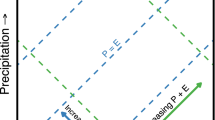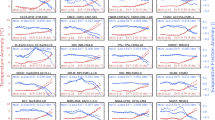Abstract
We do not deny the obvious importance of global warming and decrease in diurnal temperature range (DTR) due to greenhouse effects, which are present in both surface-station observations and the NCEP/NCAR 50-year reanalysis (NNR). Moreover, the NNR shows the largest warming trend over the past two decades, as reported in the surface-station data, suggesting that the NNR captures the dominant greenhouse-warming effect.
Similar content being viewed by others
Cai and Kalnay reply
Our study1 attributes the differences between the two data sets largely to land-use changes because the NNR is not subject to local surface influences. We deliberately used raw (unadjusted) surface observations and pointed out that the multiple non-climatic adjustments are uniformly positive, so our estimate should be considered as the lower bound of the effect of land-use changes. As we pointed out and Vose et al. confirm, adding these non-climatic adjustments to our lower-bound estimate does not alter the sign of the estimated land-use change effect but increases its magnitude.
Trenberth's comment that the reanalyses do not include the effects of the changing atmospheric composition seems to be based on the common misunderstanding that if the model used as a first guess does not have a carbon dioxide trend, for example, then the reanalysis may at best include only a 'watered-down' greenhouse-warming trend.
We showed by using an analytical study that the reanalysis can capture essentially the full strength of climate trends caused by the increase in greenhouse gases, even if this forcing is absent from the model used in the data assimilation (our unpublished data). This is because the reanalysis assimilates atmospheric temperatures and other observations that are affected by greenhouse gases and other changes. We point out that, even though the model has no volcanic aerosols, a reanalysis can capture the atmospheric heating resulting from volcanic eruptions2.
The fact that both station observations and the NNR exhibits a decrease in DTR reflects the impact of an increase in low-level clouds3. However, the surface observations show an even larger decrease in DTR, and we attribute the difference largely to land-use changes. This agrees with previous studies showing that urban effects also have a substantial impact on the decrease of DTR4.
The non-climatic adjustments can be added a posteriori to our estimate, leading to an upper-bound estimate of the impact of land-use changes. According to the calculations made by Vose et al., the non-climatic adjustments to these raw station observations yield an averaged increase of 0.112 °C per decade. In other words, half of the averaged increase between 1960–1979 and 1980–1999 derived from the HCN data set (0.224 °C per decade) is the result of the non-climatic adjustments to the raw station observations.
Adding these non-climatic adjustments to our lower-bound estimate of the impact of land-use changes (0.035 °C per decade) yields 0.147 °C per decade. This upper-bound estimate is comparable to another study that also used the HCN data (0.12 °C per decade5). Therefore, the upper-bound estimate is not ten times the size of the largest published urban estimates for the United States.
We found that a decrease in the effect of total land-use change in 1960s–1970s to 1980s–1990s took place, primarily, over the rural stations. Reforestation, saturation of urban heat-island effects, and more regulated land-use changes could be leading factors resulting in such a decrease in land-use change. This decrease is independent of, and in no way contradicts, the “dramatic increase in temperature during the past two decades” because the NNR estimate also registers a larger increase in the daily mean surface temperature equal to 0.254 °C per decade over the past two decades, which is comparable with the estimate (0.343 °C per decade) derived from the HCN data set.
References
Kalnay, E. & Cai, M. Nature 423, 528–531 (2003).
Anderen, U., Kaas, E. & Alpert, P. Geophys. Res. Lett. 28, 991–994 (2001).
Dai, A., Trenberth, K. E. & Karl, T. R. J. Climate 12, 2451–2473 (1999).
Gallo, K. P., Easterling, D. R. & Peterson, T. C. J. Climate 9, 2941–2944 (1996).
Kukla, G., Gavin, J. & Karl, T. R. J. Climate Appl. Meteorol. 25, 1265–1270 (1986).
Author information
Authors and Affiliations
Corresponding author
Rights and permissions
About this article
Cite this article
Cai, M., Kalnay, E. Impact of land-use change on climate. Nature 427, 214 (2004). https://doi.org/10.1038/427214a
Issue Date:
DOI: https://doi.org/10.1038/427214a
This article is cited by
-
Spatiotemporal variability in spate irrigation systems in Khirthar National Range, Sindh, Pakistan (case study)
Acta Geophysica (2020)
-
Interdecadal changes in winter surface air temperature over East Asia and their possible causes
Climate Dynamics (2018)
-
Using multi-model ensembles to improve the simulated effects of land use/cover change on temperature: a case study over northeast China
Climate Dynamics (2016)
-
Impact of land use/land cover change on changes in surface solar radiation in eastern China since the reform and opening up
Theoretical and Applied Climatology (2016)
Comments
By submitting a comment you agree to abide by our Terms and Community Guidelines. If you find something abusive or that does not comply with our terms or guidelines please flag it as inappropriate.



